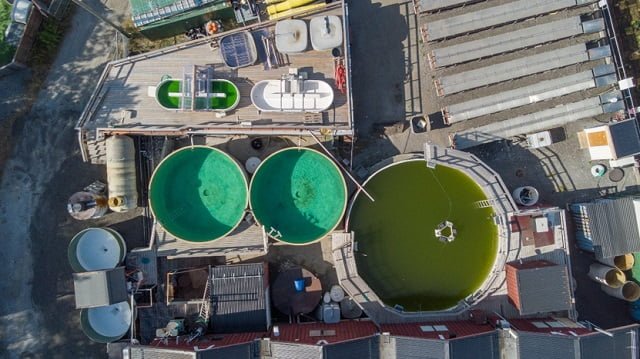
by Norwegian Institute for Water Research (NIVA)
The researchers and industry partners behind the ALGECO project believe so. They are well underway with studies and experiments on (re)use of our tertiary municipal wastewater.
- ALGECO aims to develop innovative and cost-effective technologies to transform municipally treated wastewater from waste into viable algae-based products, says Margarida Costa, project manager and research manager at the Norwegian Institute for Water Research (NIVA).
“Algae blooms” under controlled conditions
Nutrients in the water can cause algae blooms that can make swimming unappealing, but it may also affect the living conditions for fish and other aquatic species. Such problems have received much attention in recent years.
It has been verified that one of the primary causes of algae bloom is our wastewater. Although most of the nutrients in the wastewater can be removed in wastewater treatment plants (WWTPs), there is still a certain amount of N and P macronutrients released with the treated water. These are resources that could be used for other purposes.
Instead of triggering natural algae bloom in the ecosystem, why can’t we utilise these nutrients to culture algae on purpose? This is what the researchers are investigating in ALGECO. By using algae as a part of the cleaning processes, they hope that much more of the nutrients will be absorbed from the wastewater but valorised in algae bioproduct.
Can be turned into new products
The researchers hope to convert the nutrients extracted from municipal wastewater into products of algae-based organic fertilizers or soil ameliorators for Norwegian horticulture.
This project can shed light on the algae bioremediation technology for a circular process in wastewater treatment services, as well as an important contribution toward the green shift of WWTPs.
Behind the acronym ALGECO, which stands for Cost-effective ALGae technology to promote circular ECOnomy development of Norwegian wastewater treatment plants, is a consortium consisting of Norwegian and international researchers, leading industry players and innovators.
Together they have a zero vision for wastewater management, driven by the so-called 3 Rs principles: Reduce, Reuse, Regenerate.
The largest WWTP in Norway, Veas, is one of the ALGECO partners. They hope the project can contribute towards the goal of zero harmful discharges from the plant.
- The approach and focus in the ALGECO project are well aligned with Veas’ visions towards 2040, where we aim towards no discharge of harmful levels of nutrients to the Oslofjord, reducing CO2-emissions, valorising the resources in the wastewater and being an active contributor to sustainable community development. A project that successfully contributes to development of a water remediation technology for full scale application in the WWTP, within reasonable investment costs, would contribute to a high target achievement towards our strategic goals, says Rune Holmstad, senior project manager in Veas.
Social economy and biotechnology
The project team consists of highly experienced research groups with complementary expertise and experience in microalgae, biotechnology, molecular systematics, soil chemistry, plant science and environmental economics.
The project group also includes social economists, who will assess whether the process provides a basis for becoming a new, sustainable value chain for WWTPs.
During the project period, ALGECO will:
Test which species of algae are best suited for cultivation in wastewater
Conduct experiments with selected algae cultures in municipal wastewater from Veas.
Explore the opportunities for reusing the algae biomass.
Run trials with plant and soil tests to ensure that the products are safe to use.
Explore market opportunities for the new technology and products developed.
ALGECO will be implemented in collaboration between NIVA, SINTEF Energy, NMBU, UiA, UiO, NIBIO and the University of Queensland in Australia, with Bioskiva AS and Veas as industrial partners.
The project is funded by the Research Council of Norway, and lasts until September 2025. You can follow the development on the project website www.alg.eco.
Editor at the digital magazine AquaHoy. He holds a degree in Aquaculture Biology from the National University of Santa (UNS) and a Master’s degree in Science and Innovation Management from the Polytechnic University of Valencia, with postgraduate diplomas in Business Innovation and Innovation Management. He possesses extensive experience in the aquaculture and fisheries sector, having led the Fisheries Innovation Unit of the National Program for Innovation in Fisheries and Aquaculture (PNIPA). He has served as a senior consultant in technology watch, an innovation project formulator and advisor, and a lecturer at UNS. He is a member of the Peruvian College of Biologists and was recognized by the World Aquaculture Society (WAS) in 2016 for his contribution to aquaculture.
